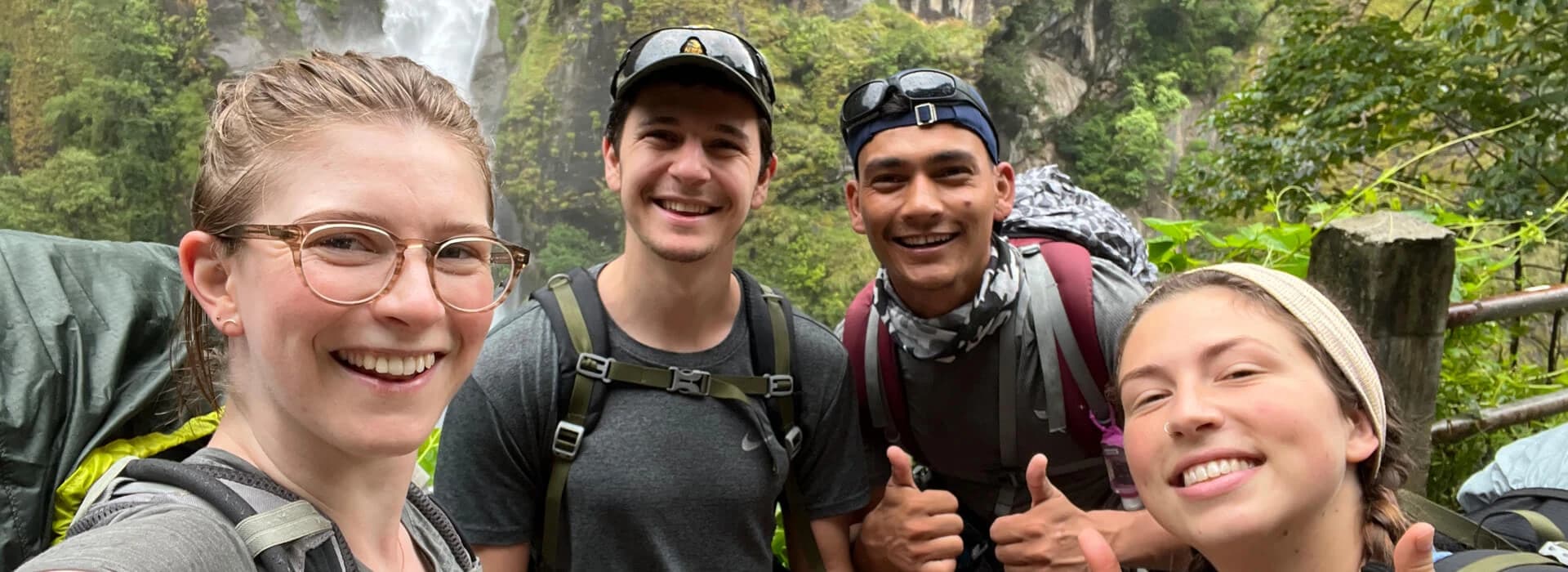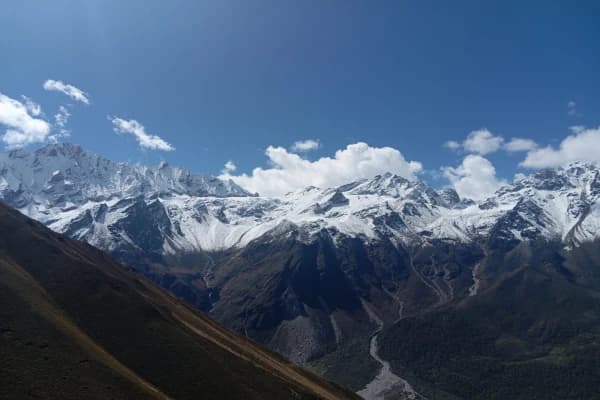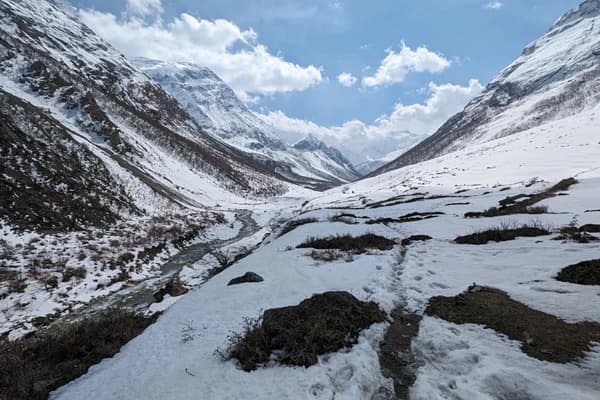Trekking in Nepal during July and August is not impossible but risky. These months, including June, fall in the monsoon, and we all know very well that, during this season, heavy rainfall is certain. As a result, it is considered off-season for trekking or any outdoor recreational activities.
Most people get their plans cancelled due to frequent rain. But it does not mean you can't afford to take risks for a worthy reward just because it could pour outside anytime soon.
After all, adventure is all about leaving your comfort zone for something new or a unique experience. It includes risk, danger, and challenge, even a little.
You can't expect an easy way out when trekking at high altitude locations like the Annapurna and Everest Regions. Adventure is divided into two categories: soft and hard, and trekking falls under the hard category. So, you'll experience hardship at some point, even if it is just for once, while immersing yourself in the wild.
Among the adventure activities, trekking is one of the best and most common, as it is suitable for people of almost every age group, and you don't need any advanced training to enjoy the walk in nature. In the context of Nepal, it's basically done in a remote location at a higher altitude.
While hiking in the mountainside of Nepal, the more you ascend, the more you witness the real beauty of nature that, without a shadow of a doubt, you'll find is different from any other place in the world. In this blog, I'll clarify the Monsoon season to trek in the country.
Anyway, if you still want to experience extreme adventure, you will also be aware of the destinations where you are eligible to trek even during the rainy season. In addition, you'll also learn how to prepare for the journey in such a time to make it successful.
Why Trekking In Nepal During July And August Is Challenging?
Trekking in Nepal during July and August is challenging, even if the difficulty level of the trek is moderate because of the following reasons that are listed below:
- High chance of natural disasters, such as a landslide, flood, and avalanche.
- Trails mostly get wet, muddy, and slippery, making walking difficult and may cause injuries.
- Cloud covers the mountains most of the time, blocking the mountain views.
- High chance of heavy rainfall in lower elevations below 3,000 m (9,843 ft), causing your body to remain wet most of the time, which may worry your immune system and make way for altitude sickness to affect you.
- Humidity is higher at lower altitudes, making it hard for your body to cool down and making you feel tired or uneasy during trekking.
- Snowfall is possible at high elevations, unexpectedly, if there is continuous downpour at lower altitudes, leading you to go through extreme cold temperatures like winter.
- Leech attacks are common in the grassy area, causing you to scratch the wound frequently while hiking and wouldn't allow you to enjoy your journey to the fullest.
- Most tea houses along the route stay closed during the monsoon due to the off-season, making it hard to find proper accommodation for an overnight stay.
Trekking In Nepal During July And August: Advantages Despite The Challenges
Even though you now know the consequences that you may encounter while trekking in Nepal during the monsoon season, you can still have some advantages:
- Villages, valleys, and hills turn into lush green heaven, with waterfalls in their most astonishing form, offering nature lovers and photographers a golden chance to capture the landscapes.
- No traffic on the trails, providing you with the opportunity to enjoy nature peacefully and interact with the locals to learn about their way of life and culture.
- Despite the almost regular rain in the morning, the skies often get clear after that, offering you stunning views of the mountains and the nearby area.
- You can experience the fresh smell of earth, encounter beautiful insects like a giant moth, and get a chance to taste freshly harvested vegetables at local hotels along the way.
- During the rainy season, festivals related to agriculture happen in various parts of the country, allowing you to see and even participate in events with the locals.
Tips For Trekking In Nepal During July And August
With all my experience of going for a trek during the rainy season in Nepal, I provide you with some of the best tips that'll definitely help you succeed in your journey to the destinations that are mentioned above in the table in the early section. They are as follows:
Proper Gear:
Carry water-resistant items, such as a raincoat, umbrella, boot gaiters, quick-drying layers, and a few plastic bags. It'll be much better if your trekking shoes are also made with waterproof material.
Insect Repellent Spray:
In the monsoon, leeches are common, especially in grassy areas or forests. Their bite will certainly disturb you from enjoying the trek, and also, some other insects like mosquitoes are highly active at the lower altitude sections of the Himalaya. Hence, repellents like Odomos and other sprays or creams are a must while trekking during the rainy season.
Leeche just suck your blood but usually cause you no more harm than making you itch frequently. It's a mosquito that could infect you with dengue, which is very high during the monsoon, and you surely don't wanna deal with.
Begin Hike Early:
During the monsoon, always be smart by starting the hike as early as possible in the morning, because in the afternoon, the rain is supposed to happen most of the time. The more you delay beginning your hike, the more there'll be a chance of getting wet and cold, causing you to get sick.
Even if you don't get sick instantly, your clothes don't get enough time to dry once they're thoroughly wet, and I know you don't wanna stroll around the Himalayas with wet clothes on. You may get sick sooner or later while hiking with your wet clothes on, and getting sick at high elevations is a dangerous sign of altitude sickness.
Stay Updated With The Weather Forecast:
It'll always be best for you to check the weather forecast for the dates of your journey, and also, during trekking. If you're mapping out a monsoon trek in Nepal, then it's mandatory to check the forecast.
However, even if your plan is in spring or autumn, you'll still need to check the weather because it's always considered unpredictable and can turn on you at any time. Thus, to stay on the safe side, you should act smart by sticking with the weather forecast.
Hire Local Guides:
As per Nepal's government law, it is compulsory to hire a local guide or go through the local trekking agency to trek anywhere within Nepal. It's for your greater good. Even if you're confident in yourself and think you can make it on your own, sometimes things don't go your way, and you could be in trouble.
No matter how much information you've gathered before visiting here to prepare for a monsoon trek, it won't be enough for you to be on the right side of heaven. Online information may not always be sufficient, and we cannot just rely on it every time.
So, if you hire at least a guide, they can provide detailed information regarding the trail. If, unfortunately, something bad happens to you, like injuries due to bad weather conditions or altitude sickness, they can bring you to safety.
Most importantly, they won't let that happen to you in the first place. A professional guide always gives their best and takes full responsibility for you and your belongings.

What Are The Top Destinations For Monsoon Trekking In Nepal?
Now that you've already learnt what it's like to trek in Nepal during the monsoon season: challenges, benefits, best seasons, and everything. Overall, it is hard in difficulty, but not impossible.
It's wise not to plan a trek in any of these months: June, July, and August. Nevertheless, if you're the one who seeks an extreme adventure most of the time or are an experienced trekker confident of handling circumstances, then you can plan a trip to a high-altitude location in the country.
Not all destinations are okay for your trek during the rainy season. Anyway, there are limited destinations that are located in the rain shadow area of the country available to experience, which I have listed below for your convenience:
Upper Dolpo Trek:
Location: Dolpa District, Karnali province, Mid-Western Development Region
Difficulty Level: Very Challenging
Highest Elevation: Kang La or Nagdalo La Pass, approximately 5,350 m (17,552.49 ft)
Duration: 23-28 days
Temperature: Approximately 12°C to 20°C in the daytime and 0°C to 5°C at nighttime
Mountain Range: Dhaulagiri
Permits: Shey Phoksundo National Park Entry Fees, Upper Dolpo Restricted Area Permit (RAP), and Trekkers' Information Management System (TIMS) Cards
Major Attractions: Shey Phoksundo Lake, Tibetan Buddhist Culture, and Peaks, such as Dhaulagiri (8,167 m/ 26,795 ft), Putha Hiunchuli (7, 246 m/23,773 ft), etc.
Upper Mustang Trek:
Location: Mustang district, Gandaki province, Western Development Range
Difficulty Level: Moderate
Highest Elevation: Approximately Lo Manthang (3800 m/12,467.19 ft)
Duration: 12-14 days
Temperature: Approximately 22°C to 30°C in the daytime and 0°C to 5°C at nightitme
Mountain Range: Annapurna and Dhaulagiri
Permits: Annapurna Conservation Area Permit (ACAP), Upper Mustang Restricted Area Permit (RAP), and TIMS Cards
Major Attractions: Lo Manthang, Tibetan Buddhist Culture, and Peaks, such as Dhaulagiri (8,167 m/ 26,795 ft), Tilicho Peak (7,134 m/23,406 ft), Damodar Peak (6,004 m /19698.16 ft), etc.
View Itinerary
Annapurna Circuit Trek:
Location: Lamjung, Manang, & Mustang districts, Gandaki province, Western Development Range
Difficulty Level: Moderate to Challenging
Highest Elevation: Thorong La Pass (5,416 m/17,769.03 ft)
Duration: 10-14 days
Temperature: Approximately 15°C in the daytime and 7°C at nighttime
Mountain Range: Annapurna
Permits: ACAP and TIMS Cards
Major Attractions: Thorong La Pass, Green Lake, Gurung & Tibetan Buddhist Culture, Bhrathang Apple Farm, Manang Valley, Ice Lake, Milarepa Cave, Gangapurna Lake, and Peaks, such as Annapurna II (7,937 m/26,040 ft), Tilicho Peak (7,134 m/23,406 ft), Pisang Peak (6,091 m / 19,984 ft), Chulu East (6,189 m/20,299 ft), Gangapurna (7,455 m/24,459 ft), etc.
View Itinerary
Nar Phu Valley Trek:
Location: Manang district, Gandaki province, Western Development Range
Difficulty Level: Moderate to Challenging
Highest Elevation: Kang La Pass (5,320 m/17454.07 ft)
Duration: 14-16 days
Temperature: 20°C to 25°C in the daytime and -3°C to 5°C at nighttime
Mountain Range: Annapurna
Permits: ACAP, Nar Phu Restricted Area Permit (RAP), and TIMS Cards
Major Attractions: Nar Phu Valley, Ancient Tibetan Buddhist Culture, and Peaks, such as Annapurna II (7,937 m/26,040 ft), Tilicho Peak (7,134 m/23,406 ft), Pisang Peak (6,091 m / 19,984 ft), Chulu East (6,189 m/20,299 ft), Gangapurna (7,455 m/24,459 ft), etc.
View Itinerary
All these treks stated above are suitable for a monsoon trek in Nepal. However, know that just because they’re all located in the rain shadow section of the country doesn't mean you will face no problems at all while trekking.
Yes, these destinations experience very low rainfall, but only in the upper section. In the lower sections, the heavy showers are common, like in the other parts of the country. Therefore, you may face obstacles like muddy and slippery trails, a landslide, an increase in water level in rivers, etc., while crossing the lower area to reach the upper area






.webp)


